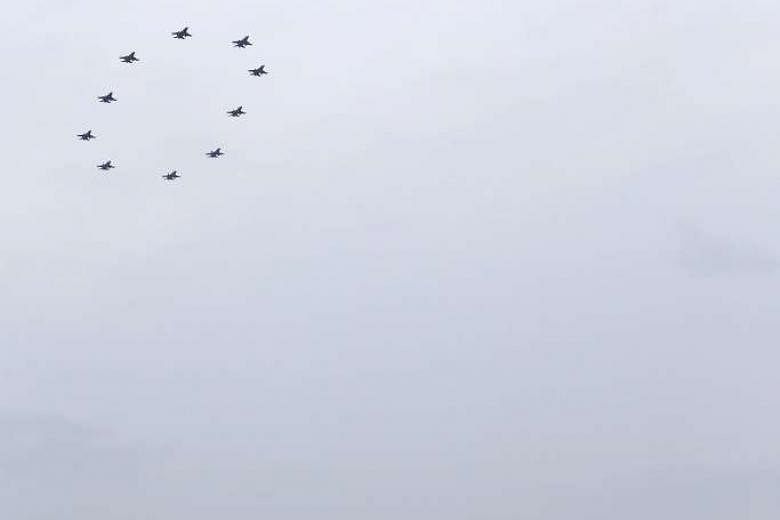This was a year of celebration, commemoration and reflection for Singapore, the nation that founding Prime Minister Lee Kuan Yew described as "improbable (and) unlikely".
When Singapore was thrust into independence in 1965, following its expulsion from the Malaysian Federation, few believed it would overcome the economic, geopolitical and demographic forces lined up against it.
It was a little red dot in a dangerous part of the world, without natural resources or an army of its own. And its people, made up of recent immigrants, had a history of communal tensions.
But today, 50 years on, the nation that should not have been is not only a beacon of what determination and grit can make possible, but also a symbol of defying the odds and overcoming vulnerabilities.
In five decades, Singapore has transformed from a Third World entrepot into a First World metropolis, with gross domestic product per capita soaring 100 times from US$500 (S$708) at independence to US$56,000 this year.

And Singaporeans of different races, religious beliefs and ethnicities enjoy relative peace and harmony in a multiracial society. It would make any nation strut with pride.
Singapore was no different. For 12 months, the country basked in the glory of its achievements, with a long list of SG50 activities. From mega-ticket events such as the SEA Games and National Day Parade to community activities led by Singaporeans, almost every child, teenager, working adult and senior was bitten by the SG50 bug.
The celebratory mood was further enhanced when Singaporeans were given an extra public holiday on Aug 7. It made for an extended Jubilee weekend over four days - from Aug 7 to 10 - for Singaporeans to "commemorate this special milestone year in our history", said President Tony Tan Keng Yam when announcing the public holiday.
In fact, the SG50 Steering Committee set up to plan the Golden Jubilee festivities had started its work two years before, in 2013.
Prime Minister Lee Hsien Loong in unveiling the committee then, had said: "Fifty years is a milestone, I don't think we should just have a fireworks display and a party."
The celebration was meant to be a unifying force for Singaporeans to identify as one people.
By the time the country celebrated its birthday on Aug 9, there was a palpable sense of patriotic pride in the air. Singaporeans cheered, sang and teared at the three-hour-long extravaganza at the Padang, where the first post-independence National Day Parade was held in 1966.
Spectators were treated to an unprecedented formation of 20 F-16 fighter jets flying at 600kmh, forming the number 50.
There was also a vintage parade segment, featuring pioneer policemen, nurses, firemen and soldiers in uniforms they wore during parades in the 1960s.
But a tinge of sadness marked the celebratory mood as people mourned the death of founding Prime Minister Lee Kuan Yew, who died in March, aged 91.
This year's National Day was the first since independence without Mr Lee in the stands.
His absence, however, made hearts grow fonder of the many moments associated with the man and reminded Singaporeans of the values of multiracialism, meritocracy and equality which he stood for.
Amid the celebration, a growing sense of national identity emerged and Singapore, often in search of itself, seemed to shed some of its existential angst.
Nowhere was this more obvious than during a segment of the parade in which some uniquely Singaporean traits - which were once considered undesirable - were trotted out as proud symbols of the Singaporean identity.
There was a giant tissue packet with the word "chope", or reserve, acknowledging the habit of using tissue packets to reserve seats at hawker centres, and a giant squid with the words "blur like sotong", giving a nod to the Singlish phrase to describe a person's confusion.
SG50 paraphernalia had also become coveted items for many.
This year, goodie bags, typically given to those attending the National Day Parade, were handed out to all 1.2 million Singaporean and permanent resident households.
The special SG50 funpack came in 50 different designs and contained nostalgic items such as childhood card games, erasers with country flags on them, and snacks such as muruku and haw flakes.
Despite the initial indifference that met the launch of the SG50 logo, Singaporeans were soon caught up in the SG50 whirl, buying T-shirts for their own Jubilee parties and decorating their cars with red dots made of foam.
It was perhaps fitting that the "little red dot" - coined by former Indonesian president B.J. Habibie, reportedly to remind Singapore of its place in the world - had been remade as a symbol of the nation's spirit, "signifying that our dreams are not limited by the physical size of our island nation", as the SG50 Steering Committee's website says.
In the end, some 1.7 million people turned up over the Jubilee Weekend, from Aug 7 to 10, to mark Singapore's coming of age.
As a testament to its diplomacy over the years, friends from around the world came for the celebrations.
Foreign dignitaries from 18 countries, including seven heads of state and government, were invited to this year's parade, a first since 1969.
They included Brunei's Sultan Hassanal Bolkiah, Malaysia's Prime Minister Najib Razak, Thailand's Prime Minister Prayut Chan-o-cha and New Zealand's Prime Minister John Key.
In November, Chinese President Xi Jinping paid a visit to Singapore, his first since becoming president, marking the 25th anniversary of Sino-Singapore ties.
In the same month, Indian Prime Minister Narendra Modi, the leader of Asia's biggest democracy, also made his first visit to Singapore to commemorate 50 years of diplomatic ties.
Singapore's President Tan, in turn, made state visits to several countries, including China, France and New Zealand.
Even before the year comes to a close, ever-pragmatic Singapore is already looking to SG100.
To keep the SG50 spirit going and to get Singaporeans working towards a shared future, the Government is holding the Future Of Us exhibition this month, and the SGfuture series of dialogues to start the journey into the next 50 years.
Opening the exhibition, PM Lee had said: "It is up to each one of us to voice our hopes and future dreams, to make the choices to realise these dreams."


